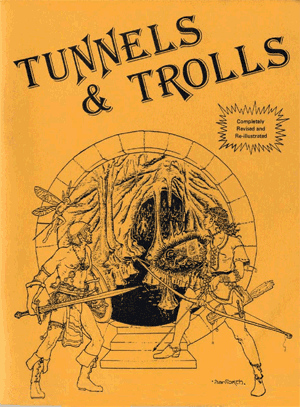Tunnels and Trolls

"This book is dedicated to Dave Arneson and Gary Gygax, who first opened Pandora's box, and to Ken St. Andre, who found it could be opened again."—RuneQuest, 2nd edition rulebook
In April 1975, Ken St. Andre borrowed a 1st edition Dungeons & Dragons set from a friend. He found that he liked the concept but disliked the miniature wargame style of play, the use of polyhedral dice, alignments and clerics. He decided to write his own rules set and play the game with that instead. After two months of playing the game with his friends and rewriting it based on experience, he printed the forty-page 1st edition rules book in a first run of one hundred copies. By then, Dungeons & Dragons had effectively trademarked what had been a generic term for tabletop role-playing games—so his first choice was out. The rules were instead published as Tunnels & Trolls.
Up to the beginning of the 1980s, T & T enjoyed moderate success, reaching its classic 5th edition in 1979. Then competition from a large number of new games, as well as significant rewrites of older games like D & D, pushed it into obscurity. According to the Other Wiki, in 1999 Pyramid magazine named Tunnels & Trolls as one of The Millennium's Most Underrated Games. It still has its loyal followers in many countries, though. In 2005 a 30th Anniversary Edition (aka 7th edition) was published with modernized rules.
Tunnels & Trolls uses only six-sided dice for game mechanics, and the principle of simplicity and uniformity permeates the rules. Compared to the infamously convoluted and cryptic 1st ed Dungeons & Dragons rules, the Tunnels & Trolls rules were clearly laid out and well-explained. T & T was also less serious-minded than D & D: the tone was lighter, gameplay was oriented towards having fun, the spell names are mostly cute or punny, or both. However, the game is not joke-oriented as a whole—it is a sound RPG.
Some of the significant innovations of T & T were:
- Armor reducing damage, not probability of hitting.
- Spell points instead of a Vancian Magic system.
- Attribute-based saving rolls
- The solo adventure format
- An Adventurer Is You
- Character Alignment—Emphatically averted.
- Character Customization
- Character Level—In editions up to 5th.
- Combat Medic—Healing (properly Poor Baby) is a wizard spell.
- Damage Reduction
- Dungeon Crawling
- Experience Points
- Fighter, Mage, Thief—almost, but not quite. There are the types Warrior, Wizard, and Rogue (and Warrior-Wizard), but they're not classic classes and the Rogue is not a Thief but a free-lancing Wizard.
- Five Races—except it's six: there are two Fairy races, actual Fairies and Leprechauns.
- Game Master
- House Rules—strongly and actively encouraged by the designer, and fan-submitted house rules have found their way into the official set on a number of occasions.
- Linear Warriors, Quadratic Wizards
- Loads and Loads of Rules—averted.
- Luck Stat
- Magic Ampersand
- Magic Knight—Rogues, and especially Warrior-Wizards.
- Magic Wand—or rather Magic Staff.
- The Magocracy
- The Six Stats—nearly; replaces Wisdom with Luck.
- Sword and Sorcerer—It's easy to make the abilities of a warrior and wizard (or rogue, which is another kind of magic user) work together.
- Universal System—two spin-off games, Monsters, Monsters! and Mercenaries, Spies & Private Eyes used the same basic rules.
- Vancian Magic -- (Mostly) averted. T & T has spells arranged into power levels, but capacity is governed by spell points.